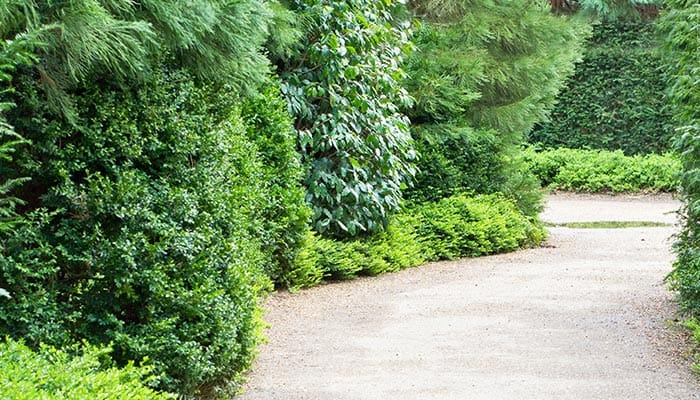 Evergreens bring color and form to the winter landscape when flowers are gone and other trees are bare and gray. Evergreens, as their name implies, stay green all year around. And they’re not just green. They come in vivid bright greens, deep forest greens, soft blue-greens, even bright gold. There are blue-toned varieties of Atlas cedar, spruce, false cypress, Leyland cypress and juniper. For golds look into Japanese holly, junipers, Leyland cypress, false cypress and Scotch pine. Some evergreens take on ruddy or bronze tones in winter. Evergreens offer a diversity of sizes and shapes, and an array of textures from prickly to soft to leathery and glossy.
Evergreens bring color and form to the winter landscape when flowers are gone and other trees are bare and gray. Evergreens, as their name implies, stay green all year around. And they’re not just green. They come in vivid bright greens, deep forest greens, soft blue-greens, even bright gold. There are blue-toned varieties of Atlas cedar, spruce, false cypress, Leyland cypress and juniper. For golds look into Japanese holly, junipers, Leyland cypress, false cypress and Scotch pine. Some evergreens take on ruddy or bronze tones in winter. Evergreens offer a diversity of sizes and shapes, and an array of textures from prickly to soft to leathery and glossy.
There are evergreen trees and shrubs, but they all fall into two basic types: conifers, which have needles and bear cones, and broadleaved plants that have leaves instead of needles and do not produce cones.
To use evergreens effectively in your landscape, consider where you want them and then choose shapes and sizes that will work.
In a lawn, you might choose a taller, pyramidal shape, perhaps a holly or false cypress. In an island bed you might want to feature an eyecatching weeping or colored plant such as a weeping blue Atlas cedar (especially interesting in a contemporary setting) or a golden Leyland cypress.
In a foundation bed near the home, choose a shrub or small tree that won’t grow large—perhaps a rounded Japanese holly or boxwood (both of which can be clipped to hold a neat shape). Or, perhaps a small pyramidal tree would suit your needs, such as a dwarf Alberta spruce (these can also be planted in large tubs to flank the front door). In a formal setting, a spiral topiary can be a good choice, although it will need periodic clipping to hold its shape. Always consider the mature height and spread of any plant you are considering placing near your house. That pretty rhododendron at the nursery may eventually grow to obscure the living room windows. Don’t put in a plant that will grow too large for its space.
For screening along a property line, look for a narrow upright plant and set a row of them close together. Leyland Cypress is widely used in this area for screening, as is arborvitae (which is eaten by deer on many properties). For a lower hedge to define or divide space, a broad-leaved evergreen that can be clipped may do the trick. Options include Japanese holly, boxwood (which has been attacked by insects in recent years), and yew (which deer may eat if your property is not fenced).
To find the best plants and varieties for your needs, consult with knowledgeable nursery staff. Plants’ botanical names can also offer clues to their shape or color. Here are some clues to look for on nursery tags: Aurea indicates golden color, Argentea indicates silvery and Glauca describes a bluish color. In terms of shape, Columnaris and Fastigiata both describe slender, columnar plants, Globosa indicates a rounded form, Pendula means weeping and Pyramidalis describes a pyramid shape.
Evergreens are versatile additions to any landscape. They’re easy to care for, can’t be beat for winter color, and can serve as a backdrop for summer flower gardens.








